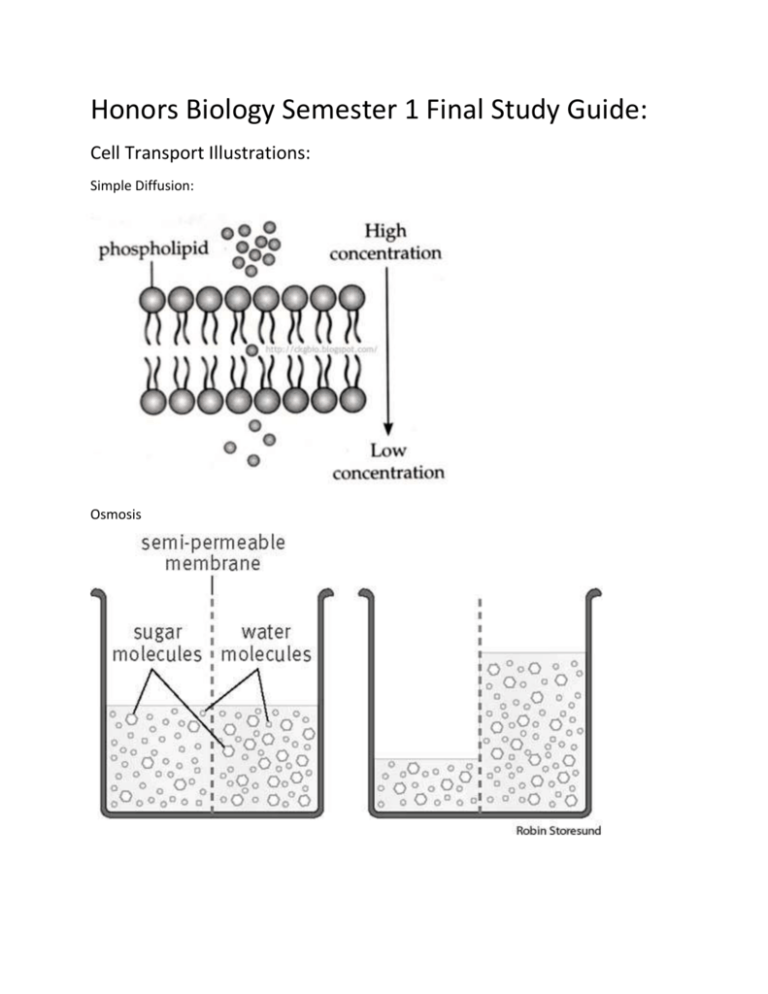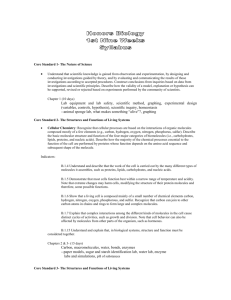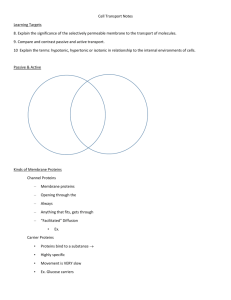Honors Biology Semester 1 Final Study Guide
advertisement

Honors Biology Semester 1 Final Study Guide: Cell Transport Illustrations: Simple Diffusion: Osmosis Sodium-Potassium Pump: Exocytosis/Endocytosis Active vs. Passive Transport: Passive transport means the cell is not really doing anything to encourage the movement of molecules. This can happen because molecules naturally move from areas of high concentration to areas of low concentration. This is what occurs during both types of diffusion and osmosis. On the other hand, active transport requires ATP from the cell to move molecules. In the case of the sodium-potassium pump, ATP is used during active transport to move sodium and potassium from areas of low concentration to areas of high concentration. Concentration: Concentration refers to how much of a substance is in a given area. An example of this is that at the intersection of D and F hallways, there is a high concentration of people. When you are alone in the hallways during class, there is a low concentration of people. Concentration Gradient: A concentration gradient is defined as a measurement of how concentration changes as you move from one place to another. Imagine as you move down D hallway, the concentration of people becomes lower and lower as you walk. Cell Membrane: A cell membrane is formed of rows of polar heads attached to non-polar tails. The polar heads are hydrophilic, meaning water loving, so they face outwards towards an area of water. The non-polar tail is hydrophobic, or afraid of water, so it faces inwards. The membrane is responsible for controlling what enters and exits the cell, specifically for moving nutrients in and waste out. This quality of moving only certain things gives it the title “selectively permeable.” Bacterial, Plant, and Animal Cells: The main difference between bacterial cells and plant/animal cells is that bacteria cells are prokaryotic while plant and animal cells are eukaryotic. Prokaryotic cells are simpler than eukaryotic cells, containing no set nucleus and being much smaller. Eukaryotic cells are larger, more complex, and evolved more recently. There are also differences between plant and animal cells. Plant cells have a cell wall, a large central vacuole, and chloroplasts, while animal cells do not have these things. Animal cells contain lysosomes which plant cells lack. Organelle Structures and Functions: Organelle Ribosomes Endoplasmic Reticulum Rough ER Smooth ER Mitochondria Golgi apparatus Vesicles Lysosomes Peroxisomes Cytoskeleton Microtubules Microfilaments Intermediate Filaments Centrioles Structure Small and almost spherical. Not membrane-bound. Made of proteins and ribosomal RNA. Network of tubes that connect the cell membrane to the nucleus. ER covered in ribosomes ER not covered in ribosomes Enclosed by a membrane, contains a folded membrane (cristae) designed to increase surface area Set of flattened sacs bound with membranes Membrane bound sacs filled with specialized compounds Vesicle that comes from the Golgi and is filled with digestive enzymes Vesicles produced in the ER Set of thin tubes and filaments Hollow tubes Two twisted strands Coiled cables Short sets of microtubules at right angles Function Build proteins using RNA instructions Produces lipids and proteins, and sometimes other cellular products Produces proteins Produces lipids Converts organic molecules (glucose) to ATP Receive and label compounds from the ER Carry compounds designed for a specific purpose through the cell Breaks down large molecules, and old organelles and cells. Break down toxic molecules Provide shape and support Provide support to cell Contract muscles to change the cell shape Hold nucleus in place Organize microtubules during cell division Cilia Short, hair-like structures Flagella Long, tail-like structure Central Vacuole Large, fluid-filled sac, up to 90% of cell’s volume Chloroplasts Double membrane with stacks of flattened sacs (thylakoids). Contains chlorophyll Move cell through beating motion, like a rowboat Move cell through moving back and forth Stores water, enzymes, and waste. Controls pressure in plants Site for photosynthesis Elements of Biological Molecules: Carbohydrates: Carbon, hydrogen, oxygen (1:2:1 ratio) Lipids: Carbon, hydrogen, and oxygen (No set ratio) Proteins: Carbon, hydrogen, oxygen, nitrogen Nucleic Acids: Carbon, hydrogen, oxygen, nitrogen, phosphorus Monomers of Biological Molecules: Carbohydrates: Monosaccharides Lipids: Glycerol and fatty acids Proteins: Amino acids Nucleic Acids: Nitrogenous base, phosphate group, sugar Cellular Uses of Biological Molecules: Carbohydrates: Gives energy Lipids: Stores energy, phospholipid bilayer, cholesterol Proteins: Regulate chemical reactions, transport proteins Nucleic Acids: Directs activities, stores genetic information Organismal Uses for Biological Molecules: Carbohydrates: Energy Lipids: Stores energy, hormones, steroids, protects organs Proteins: Control reactions, muscles, keratin, hormones Nucleic Acid: Controls all functions, codes for proteins (traits) Interdependence between Plans and Animals: During cellular respiration, animals release carbon dioxide. Plants need carbon dioxide to perform photosynthesis, which then produces oxygen. This oxygen is then recycled again for animals to use during cellular respiration. Benefits of Stacks and Folds in an Organelle: Stacks and folds allow for greater surface area, which allows more area for a reaction to take place. Reaction of Photosynthesis: 6CO2 + 6H2O -> C6H12O6 + 6O2 Reaction of Cellular Respiration: C6H12O6 + 6O2 -> 6CO2 + 6H2O + energy Common Characteristics of Living Things: Order: Cells compose all living things. Living things exhibit consistent patterns of structure and behavior. Reproduction: Can be sexual or asexual. Creates new organisms to continue species. Growth and Development: Growth means getting physically larger. Development involves new aspects being created, or an organism becoming more complex. Energy Processing: Gives organism energy to live Response to Environment: Short-term response. Ex. fear, pupils grow bigger in dark Regulation: Homeostasis. Keeps body stable with temperature and blood pressure Evolutionary Adaptation: Long-term change of species. Ose. Vs. Ase. : The suffix “-ose” such as in glucose, fructose, and sucrose means sugar. The ending “-ase” as in catalase means enzyme. Cyto-: The root “cyto” means “cell”. Words which have this root include “cytoskeleton”, “exocytosis”, and “endocytosis.” Glyco- : The root “glyco” means sugar. Words from biology that use this root include “glycogen” and “glucose.” Hyper- vs. Hypo- vs. Iso- : The prefix “hyper” means over, while the prefix “hypo” means under. “Iso” means equal. Importance of ATP: ATP is like cellular energy currency. It allows everything in your body to move and stay alive. Cell in a Hypertonic Solution: A hypertonic solution is a solution with a high concentration of dissolved substances. When a cell is placed in a solution with a higher concentration of substances, water rushes out of the cell into the surrounding area to even out the concentrations. This causes it to contract and shrivel up. Cell in a Hypotonic Solution: A hypotonic solution is a solution with a low concentration of dissolved substances. When a cell is placed in a solution with a lower concentration of dissolved substances than are in the cell, water rushes into the cell, causing it to expand. Cell in an Isotonic Solution: An isotonic solution is a solution that has the same concentration of dissolved substances as the cell. When a cell is placed in an isotonic solution, the water coming into the cell and the water leaving the cell are equal and balance each other out. Therefore the cell doesn’t change in volume. Transport Proteins: Another name for a transport protein is a channel protein. Role of Enzymes: Enzymes play the important role of regulating chemical reactions that occur in your body. When an enzyme is working, it lowers the amount of activation energy needed for a chemical reaction to occur. Surface Markers: Surface markers are consisted of carbohydrates that function as ID tags and proteins that recognize the carbohydrate. Independent vs. Dependent Variable: The independent variable is what a scientist changes voluntarily in the experiment. The dependent variable is what changes because of the independent variable. For example, in the glucose/potato experiment, the independent variable was the concentration of glucose, while the dependent variable was the mass of the potato. Shape of Cells: The shape of a cell is determined by its function. For example, red blood cells need their small, disc-like shape to easily fit through blood vessels. Energy Organelles: The two organelles in cells involved in producing energy are mitochondria and chloroplasts. Mitochondria carry out the reaction called cellular respiration in which oxygen and glucose produce energy, carbon dioxide, and water. The reaction in chloroplasts is called photosynthesis in which carbon dioxide and water yield glucose and oxygen when light is added. Cell Membrane: The selectively permeable cell membrane has the important role of controlling what gets in and out of the cell. It needs to move nutrients in and waste out. Cilia vs. Flagella: Cilia typically occur with lots at once and move with a beating motion like many people rowing a boat. There is typically only one flagellum which moves with a back and forth motion like a snake. Cholesterol: Cholesterol is important because it helps create hormones like estrogen and testosterone. Elemental Backbone: Carbon is the backbone for all organic molecules. Combining Monomers: Monomers are created through a reaction known as dehydration synthesis, or condensation. This involves taking out a molecule of water to combine the monomers to create polymers. OH-C-C-C-H + OH-C-H -> Oh-C-C-C-C-H + H2O Breaking Down Polymers: The reaction for breaking down polymers to their original monomers is called hydrolysis. This involves putting molecules of water back in to separate the polymer. OH-C-C-C-C-H + H2O -> OH-C-C-C-H + OH-C-H Nucleic Acids: A nucleic acid has a nitrogenous base, a phosphate backbone, and sugars. Insulin: The role of insulin is to regulate blood sugar. It makes sure that you do not have too much or too little glucose in your blood. Energy in Organic Molecules: Lipids provide the most energy per gram, with 9 calories/ gram. Carbs and proteins only give 4 calories/ gram. Invasive Species: An invasive species is a species that infiltrates and environment and takes over because it has no natural predators to control its population. They cause harm because they take up an overwhelming amount of resources that would normally be used by other animal populations in the area. One example of this occurrence is in Florida where people release their pet pythons after they grow too large. The pythons then eat many other animals and lack any predators to control their own population. Primary and Secondary Succession: Primary succession occurs in areas that were previously without life, such as near a volcano after a major eruption. It is difficult for life to begin there due to a lack of soil and proper nutrients. Secondary succession occurs when an area previously inhabited is disturbed and life forms begin to return to it after the disturbance. In secondary succession, soil is already present and contains some nutrients. Biological Magnification: Biological magnification is when the concentration of a certain chemical or toxin grows stronger as the trophic level increases. For example, in low levels of the food chain off the coast of California, DDE didn’t have a large effect, but by the time it reached the eagles, it was severely impacting their ability to reproduce. Keystone Species: A keystone species is a species that without which an ecosystem would either drastically change or cease to exist all together. Limited Trophic Levels: With each level of a food chain, only 10% of the energy from the previous level is carried over. By the third or fourth level, there isn’t enough energy for higher levels to be very practical. Mutualism vs. Commensalism vs. Parasitism: Mutualism occurs when two animals help each other in a symbiotic relationship. An example of this is the bacteria living inside humans. They receive food and in exchange humans are able to digest what they eat. Commensalism is when one species is benefited but the other doesn’t really care either way. This is like when a remora feeds off the side of a whale; the whale doesn’t care but the remora gets food. Finally, parasitism is when one species is benefited while another is harmed. This is like when fleas bite dogs. It helps the fleas, but harms the dog. Humans and Nitrogen: Humans obtain nitrogen from eating plants. Humans harm the nitrogen cycle by overusing fertilizer, adding excess into the soil. Nitrogen-Fixing Bacteria: Nitrogen-fixing bacteria combine nitrogen from the atmosphere with oxygen and other elements to create compounds like NO2, NO3, and NH4. They are located on the roots of plants. Assimilation: Assimilation is the process of nitrogen-containing compounds being taken into plants. Fossil Fuels and the Carbon Cycle: Fossil fuels add carbon into the atmosphere that is not needed. Matter vs. Energy: Energy flows through an ecosystem while matter is recycled through the ecosystem. Energy at Trophic Levels: Each trophic level has about 10% of the energy of the one beneath it. This means that there cannot be many quaternary consumers because there is so little energy remaining at that trophic level. Food Chain vs. Food Web: A food chain shows flow of energy in one direction. A food web shows many connections between many species that exist. Sunlight and the Ecosystem: Plants are the producers of an ecosystem, which means that without enough energy produced from photosynthesis, there will be less species living there. Organizational Levels of Biology: Atomic Molecular Organelle Cell Tissue Organ Organ System Organism Population Community Ecosystem Biome Biosphere Density-Dependent vs. Density-Independent Factors: Density-dependent factors depend of how many organisms inhabit an area. This includes things like the amount of available resources. Density-independent factors are things like natural disasters that can occur whether there are a million organisms or one. Carrying Capacity: The carrying capacity of an ecosystem is how many organisms can live there. Immigration vs. Emigration: Immigration is people moving into a country while emigration is people moving out of a country. Homeostasis: Homeostasis is the regulation of your body’s stable temperature, blood pressure, pH and other factors. It is closely linked to the regulation factor of life. Metabolism: Metabolism is the net sum of all chemical reactions in an organism. Prokaryotic vs. Eukaryotic Cells: Prokaryotic cells have been around longer, are smaller, and are less complex than eukaryotic cells are. Exponential Growth vs. Logistical Growth: Exponential growth is growth that keeps going, assuming there are unlimited resources. Logistical growth begins like exponential growth, but eventually levels out, assuming a limited amount of resources. Logistical growth is more realistic.










